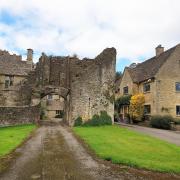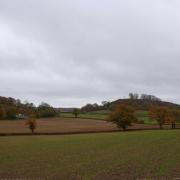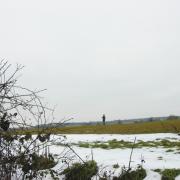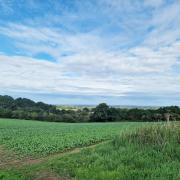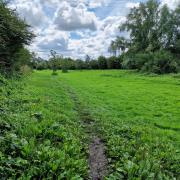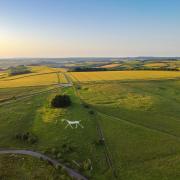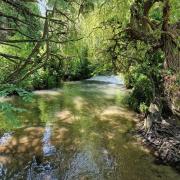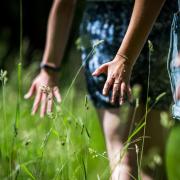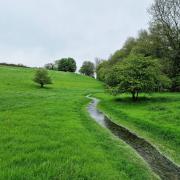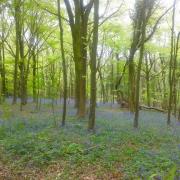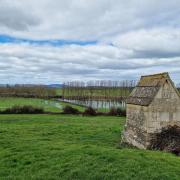A short stroll past the Purton Hulks towards Sharpness
Near the village of Purton can be found one of the most liminal places in Gloucestershire. When you walk the towpath slotted between the vast River Severn and the Gloucester and Sharpness Canal, you are suspended on such a narrow strip of earth that it’s easy to imagine being swept away. The canal and river authorities recognised that this was a real practical problem; for more than 50 years they shored up the banks of the river with disused barges, turning the place into a boat graveyard. Once, those boats were whole, but now they are skeletal creatures thrusting up through the grass and mud, and only the earth caught between their bones holds back the river.

It started with a collapse of the riverbank in 1909. Old vessels were brought down the Severn and run aground against the bank. The hulks were then holed, and in time they silted up, and after an even longer time, by the processes of earth and tide, they became embedded in the ground. Hard to imagine, when you visit, that this programme ended only a little over 50 years ago. If you come from Purton, and the picnic site after the swing bridge, it’s the concrete barges you’ll see first. Built in the Second World War but soon obsolete, these remain well preserved, as if they’d only recently been wrecked there, their tillers still swinging, although they are now overgrown with grass and reeds.

Then you turn the corner and see the rusting, rotting wooden boats. They have the appearance of skittering creatures frozen by your approach. In the spring, they dance amid the wild flowers and seem benign, but at night, and in winter, it’s a different story. Will the schooner Sally lurch up and follow you? What damage could Dispatch do with her metal prongs? Yes, we know their names. Each boat has its own plaque, thanks to the work of Paul Barnett and the Friends of Purton, who have championed and researched the hulks over the past 20 years.

Nevertheless, it’s the river that draws the eye, whether the tide is in and churning, or out, leaving an expanse of mud, pools, and wading birds. It’s said that the Severn – Sabrina to the Romans, Hafren to the Welsh – ‘always gets her man’; a reminder that the controlled, unmanned wreckings of the mid 20th century have not been the norm. The river must take a human life each year – and if there are many drownings, human or livestock, then it will be a good year for elvers! Still, the name Hafren also means ‘Summer’, and the Severn waters the summer pastures along her banks. Indeed, down by the Berkeley Arms at the end of the road from Purton you can see the beginnings of the wetlands belonging to the Wildfowl and Wetlands Trust which stretch up to Slimbridge.

At about this point along the river, where it becomes more tidal, more estuarine, the goddess begins to share her domain with a god of sea, healing, and hunting, Nodens, whose temple was found on the far bank near Lydney. Also across the river is another Purton, the opposite terminus of what was once a ferry crossing, the Purton Passage, going back to 1282. Shifts in the channels in the river made the ferry unprofitable by the mid 18th century, and it finally ceased running in 1879. If you didn’t fancy the ferry, in the late 18th and early 19th century, you could walk across here. It looks so easy, and the far bank so close … but it was a dangerous enterprise and people got drowned. The river was hazardous also for the barges – trows – that plied the river from Bristol up as far as Worcester. An old ballad, The Trowman’s Fall, says,
The seventh day of February from Bristol we sail’d out,
Our Trow was richly loaded and bound for Worcester port;
At half-past six that very night it was a dismal sound,
Our gallant ship struck on the sand and four of her crew were drown’d.

As you walk towards Sharpness through the grass and reeds on the riverbank beyond the Purton hulks, you’ll start to see a building loom up, all snaggled in foliage. This is one of the two remaining piers of the railway bridge whose 21 iron spans stretched across the river between 1879 and the 1960s. With their rusticated stonework and waving ivy, these towers look like a much older construction, redolent of the Pillars of Kings, once an entrance to Gondor, in Tolkien’s The Lord of the Rings – or so we thought in the bright sunlight!

In 1960, on a dark and foggy night, two tanker barges filled with petroleum and oil were caught in the fog and struck the bridge piers. Parts of the bridge fell down on the barges, which, being full of fuel, exploded. Fire spread out across the water. Imagine the terror of the crewmen trying to swim to safety through the fire-licked water. Jack Cooper, on the Arkendale H, nearly gave up, deciding he’d rather drown than be burnt, but as he sank under the water he had a vision of his family, giving him the strength to carry on. Astonishingly, three of the eight men made it – including Jack. The remains of the wrecks of the Arkendale H and Wastdale H can still be seen at low tide.
No ghosts are known from this disaster. But a mere 300 yards downriver is Fiddler’s Pool, where many years before another boat came a cropper. This time it was alcohol that fuelled the sinking. A party of Welsh fiddlers were returning home after a night playing and partying at Berkeley. In the darkness their boat was caught in a maelstrom, a strong whirlpool in the river. On stormy nights their frantic fiddling can still be heard, hence the maelstrom’s name of Fiddler’s Pool.

Back on the towpath, you can walk onwards to the docks at Sharpness, the erstwhile canal basin that become a port as ships grew bigger, and seek refreshments at the Dockers Club. Or, if you prefer, the remains of the bridge marks a good point at which to turn back along the canal and contemplate how pleased the people who worked on the boats, barges, and ships must have been back in 1827 when the Sharpness Canal was fully opened, at that time the broadest and deepest canal in the world, and a much safer navigation than the Severn.
When you get back to Purton, you might fancy a pint at the Berkeley Arms, but at the time of writing the pub is closed and looking for a new tenant. There may once upon a time have been other dangers hereabouts besides the river, for there are said to be witch marks on the fireplace in this pub. Are such folk beliefs no more than a troublesome nonsense? Well, possibly not. It could be that it’s the actions of local people, not the shored-up hulks, that have been defending Purton from the Severn. If you should happen to be at the river on the equinox, you may see some unusual behaviour: women walking up to the water’s edge and, wait, what are they doing? Baring their bums for Sabrina to see? Exactly that – and by doing so they’re keeping the floodwaters from riverside doors!
Essentials:
Parking: Car park in Purton.
Toilets and refreshments: Dockers Club, Sharpness. Hopefully, there’ll soon again be cream teas on Sunday’s at the church and beers at the Berkeley Arms in Purton!
Map: OS Outdoor Leisure 14 Wye Valley and Forest of Dean.
Links:
The Purton Hulks: friendsofpurton.org.uk
The Severn Railway Bridge disaster: severntales.co.uk/severn-bridge-disaster.html
Kirsty Hartsiotis is a Stroud-based writer, speaker, and storyteller. Her books include Wiltshire Folk Tales, Gloucestershire Ghost Tales, and Gloucestershire Folk Tales for Children. She is also the curator of decorative and fine art at The Wilson Art Gallery and Museum, Cheltenham.





